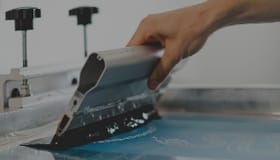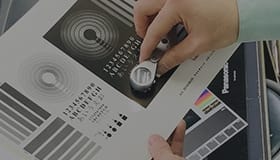Product overview
CAT 1300S ADHESIVE is a pressure-sensitive adhesive for screen printing, mainly composed of a special acrylic resin. Capable of printing free patterns by screen printing on nameplates, labels, stickers, etc. using various plastics, paper, metals, etc. as substrates, and partial adhesive processing is also possible.
- Functional ink

Application
- Pressure-sensitive adhesive applied by screen printing to membrane switches and various nameplates.
Features, Function
- High adhesive strength, excellent holding power, and excellent resistance and weather resistance.
- Superior printability and leveling
- Good stencil stability
- Adhesive, binder
Substrate
- Various plastics, paper, metals, etc.
- PC
- Easy adhesion treated PET
- Metal
- Paper
Dilution
- C-002 SOLVENT (standard) Dilution: 1 to 3%
- *Dilution is not necessary. Do not use other solvents or additives as they may adversely affect adhesion, etc.
Recommended cleaner
- Screen Cleaner L2
Mesh
- T 50 to 100 mesh(Recommended printed ink layer is 25~35μm, please print as thick an ink layer as possible)
Drying
- 80℃ 20 min or more
Caution
- Plastic substrate contains plasticizers or release agents, which may have unexpected adverse effects. Please confirm the performance thoroughly before use.
- Please note that printing CAT-1300S adhesive on screen-printed materials may cause a significant decrease in adhesive strength due to the type of ink or poor drying of the ink.
- When CAT-1300S adhesive is printed on a transparent sheet that is back printed, metallic and black colors tend to change hue slightly due to the adhesive printing. To prevent such problems, laminate the printed material with PET film, etc., before printing CAT-1300S adhesive.
- For adhesive printed materials, please affix release paper to the printed surface as soon as possible after drying to prevent adhesion of dust, etc.
- Surface of substrate should be thoroughly cleaned of moisture, oil, and other dirt before printing.
- Please do not put adhesive in metal cans and use polyethylene containers instead as it may cause color change.
- Ink shelf life: 9 months from production date, unopened
Safety
- UN No.: 1210
- UN Classification: Class 3 Flammable Liquids(Flash point is over 23 Degree C)
Handling
- Use safety gloves and eyeglasses to protect skin and eyes. If the ink comes in contact with skin, wash with soap and plenty of water (or lukewarm water) and consult with a doctor.
- Containers should be closed tightly after use and stored in a cool and dark place.
- SDS is available upon request. Please request a copy and read it carefully before handling the products.
Resistance
| Item | Results | |
|---|---|---|
| Appearance | Light yellow liquid | |
| Solid % | 50±2% | |
| Viscosity | 4000±500cps | |
| Adhesive Power g/25mm |
90°Peel ABS | 800g |
| 90°Peel SUS | 950g | |
| 180°Peel ABS | 1300g | |
| 180°Peel SUS | 2750g | |
| Holding power 1kg, 40℃ | 1mm or less | |
| Ball Tack | 15 | |
| Test item | Test Conditions | 180° Peel strength |
|---|---|---|
| Heat | 80℃ 200 hrs. | 2150g |
| Cold | -20℃ 200 hrs. | 2600g |
| Water | Soak 24 hrs. in tap water | 2270g |
| Acid | Soak 24 hrs. in 2% H2SO4 | 1900g |
| Alkaline | Soak 24 hrs. in 2% NaOH | 1640g |
| Detergent | Soak 24 hrs. in household detergent (Magiclean) | 1770g |
| Oil | Soak 24 hrs. in machine oil | 1690g |
| Weather meter | 200 hrs. | 800g |
| Reference | 2750g |
Test Condition
- Test condition
【CAT-1300 ADHESIVE】【100℃ 2 min】 【Aging: 23℃×65%RH,24 hrs.】Adhesive strength: One day after application, peel speed 300mm/min vs SUS】【Holding power: application area 25 x 25mm, 1kg weight x 1000 min】【Ball Tack:J.Dow method(23℃)】 - Above resistance test results are measured results in our laboratory and they are not guaranteed values.
- Information contained in this catalog may change without prior notice.
FAQ
-
What is screen printing?
-
Screen printing is a type of stencil printing which uses a technique of duplicating the image from a design made on mesh stencils.
When printing ink goes through the mesh, it transfers the image onto the substrate material. Other than air and water, any substrate materials are printable. Not only flat surfaces, but also curved, specially shaped, and molded products are suitable for screen printing.

